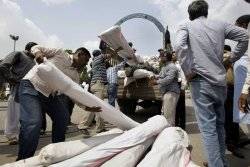Rescuers in Pakistan are striving to reach victims of a massive earthquake that struck the country's southwest, killing at least 327 people, injuring more than 500 others and flattening thousands of mud-built homes.
The 7.7 magnitude quake struck Balochistan's Awaran district on Tuesday at 4:29pm local time (11:29 GMT) at a depth of 15km.
"A total of six districts - Awaran, Kech, Gwadar, Panjgur, Chaghi and Khuzdar - and a population of over 300,000 have been affected by the earthquake," Jan Muhammad Buledi, Balochistan government spokesperson, told the AFP news agency.
"At least 200 people have been evacuated," Al Jazeera's Kamal Hyder reported from Awaran.
Officials told Al Jazeera that many people were still trapped under the rubble of collapsed buildings.
The Pakistani military, meanwhile, has said that it has commenced rescue operations in the area. Michael Higginson, the acting head of delegation for the international federation of the Red Cross and the Red Crescent, told Al Jazeera that those affected by the earthquake need shelter, medical supply food and clean water.
Abdul Qadoos, Balochistan provincial assembly's deputy speaker, told Reuters that at least 30 percent of houses in the impoverished Awaran district had caved in.
Citing officials, Syed Ali Shah, Balochistan bureau chief for Dawn News , told Al Jazeera that the death toll from the disaster had risen as rescue efforts were hampered by tough road conditions. The area was one of the most remote and underdeveloped in the country, he said.
"I spoke to some survivors and they said that since yesterday they have been waiting for relief."
"The earthquake has really affected communications in the area," he said.
New island
Tremors were felt across the province as well as in the port city of Karachi, residents have said. Mild tremors were also felt as far away as the Indian capital of New Delhi.
The earthquake was so powerful that it caused the seabed to rise and create a small, mountain-like island about 600m off Pakistan's Gwadar coastline in the Arabian Sea.
Television channels showed images of a stretch of rocky terrain rising above the sea level, with a crowd of bewildered people gathering on the shore to witness the rare phenomenon.
The epicenter was in a remote, thinly populated mountainous area of Balochistan with no major industrial installations.
Muhammad Riaz, a senior Pakistan meteorologist, told local media that the earthquake was "major" and that "heavy destruction" was likely.
Balochistan government spokesman Buledi said teams were working to recover bodies, but the priority was to move the injured to hospitals as soon as possible - a difficult task in a desolate area with minimal infrastructure.
"We are seriously lacking medical facilities and there is no space to treat injured people in the local hospitals," he said.
The scale of the territory involved is daunting. Awaran's population is scattered over an area of more than 21,000sq km.
Balochistan makes up around 45 percent of Pakistan's area but is the country's least populated and least developed province.
In April, a 7.8-magnitude quake centered in southeast Iran, close to the border with Balochistan, killed 41 people and affected more than 12,000 on the Pakistan side of the border.
PHOTO CAPTION
Pakistan volunteers load relief supplies for earthquake-affected people of the Baluchistan province, in Karachi, Pakistan, Wednesday, Sept. 25, 2013.
Aljazeera


 Home
Home Discover Islam
Discover Islam Quran Recitations
Quran Recitations Lectures
Lectures
 Fatwa
Fatwa Articles
Articles Fiqh
Fiqh E-Books
E-Books Boys & Girls
Boys & Girls  Articles
Articles










